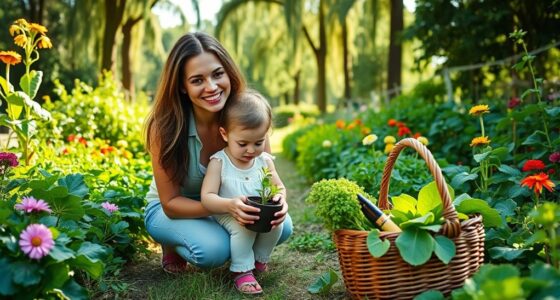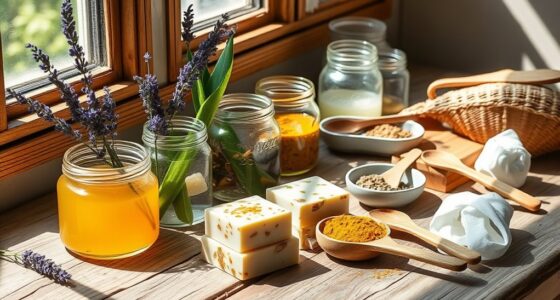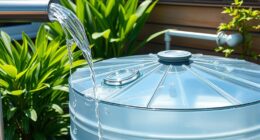Even with limited space, you can create a thriving indoor herb garden that boosts your cooking and brightens your home. The key lies in choosing the right herbs and setting up a system that works within your environment. From selecting containers to managing light and water, each step plays a role in your success. Ready to turn a tiny corner into a lush, green oasis? Let’s explore how to make it happen.
Choosing the Ideal Herbs for Your Indoor Space
Have you considered which herbs will thrive best in your indoor environment? Not all herbs grow equally well indoors, so choosing the right ones is essential. Opt for herbs that tolerate lower light levels, such as basil, mint, parsley, chives, and cilantro. These plants are adaptable and easier to care for inside. Think about your cooking habits too—select herbs you use frequently to ensure they stay healthy and productive. Avoid high-maintenance herbs that need intense sunlight or specific humidity levels unless you’re prepared to provide extra care. Keep in mind your space’s temperature and light conditions when making your choices. Proper installation and venting are essential for maintaining a healthy indoor environment, ensuring your herbs grow safely and efficiently. Picking herbs suited to your environment ensures they flourish, making your indoor garden both enjoyable and successful.
Selecting the Perfect Containers and Potting Mix
Choosing the right containers and potting mix is crucial for your herbs to thrive indoors. Opt for containers with drainage holes to prevent water buildup, which can lead to root rot. Materials like terracotta, ceramic, or plastic work well, but ensure they’re appropriately sized for your herbs’ mature roots. Remote hackathons often utilize digital platforms that support these containers and mixes, facilitating virtual collaboration and resource sharing. Small pots are ideal for limited space, but they require more frequent watering. When selecting potting mix, choose a high-quality, well-draining blend designed for herbs or vegetables. Avoid garden soil, which can be too heavy and prone to pests indoors. Instead, look for mixes with peat moss, perlite, or vermiculite that promote healthy root development and retain moisture without becoming waterlogged. Proper containers and mix set the foundation for a healthy, productive indoor herb garden.
Finding the Best Location for Your Indoor Garden
Finding the right spot for your indoor herb garden is essential to ensure your herbs thrive. Look for a location with plenty of natural light, such as a south-facing window, where your herbs can get at least 4-6 hours of direct sunlight daily.
Avoid placing your garden near heat sources, vents, or drafts, as fluctuations in temperature can stress the plants. Keep it away from busy areas where it might be knocked over or disturbed.
Choose a space with good air circulation to prevent mold and pests. If natural light is limited, consider supplementing with grow lights.
Watering and Lighting Tips for Healthy Growth
Proper watering and lighting are crucial for your herbs to stay healthy and lush. Water your herbs when the top inch of soil feels dry, but avoid overwatering, which can cause root rot. Use a watering can with a narrow spout for precise delivery, and ensure excess water drains well.
For lighting, place your herbs where they’ll receive at least 6 hours of direct sunlight daily, such as a south-facing window. If natural light is limited, supplement with grow lights to promote healthy growth. Color temperature adjustments can also help optimize your lighting conditions for better plant health.
Keep the lights about 12 inches above your plants and run them for 12-16 hours each day. Consistent watering combined with adequate light helps your herbs develop strong roots, vibrant leaves, and abundant flavor.
Maintaining Proper Humidity and Temperature Levels
Maintaining the right humidity and temperature levels is essential for your herbs to thrive indoors. Most herbs prefer a humidity level of around 40-60%, so if the air feels dry, consider using a humidifier or placing a tray of water nearby to boost moisture. Additionally, monitoring your indoor environment helps prevent issues related to improper climate control and ensures your herbs remain healthy. Avoid sudden temperature fluctuations, as herbs generally grow best between 65-75°F. Keep your herbs away from drafts, heating vents, and cold windows during winter. If your space tends to be dry in winter, mist your herbs lightly or group them together to create a microenvironment with higher humidity. Consistent temperatures help prevent stress and promote healthy growth. Regularly monitor your indoor climate to ensure your herbs stay comfortable, healthy, and vibrant.
Fertilizing and Pruning Your Herbs
Regularly fertilizing and pruning your herbs keeps them healthy and encourages vigorous growth. Use a balanced, water-soluble fertilizer every few weeks to provide essential nutrients. Be careful not to over-fertilize, as this can harm your plants. Proper plant care ensures your herbs thrive and remain flavorful. When pruning, trim back leggy or yellowing leaves to promote bushier growth and prevent disease. Use clean, sharp scissors or pruning shears to make clean cuts just above a leaf node or set of leaves. Regular pruning also helps maintain the desired shape and size of your herbs, making harvesting easier. Remove any dead or yellowing foliage promptly.
Troubleshooting Common Issues in Indoor Herb Gardening
Even with the best care, indoor herb gardens can encounter common issues like yellowing leaves, leggy growth, or pests. If your herbs start turning yellow, check if they’re overwatered or underexposed to light. Adjust watering habits and ensure they get enough sunlight or artificial light. Proper placement of your herbs is crucial for optimal growth. Leggy growth often indicates insufficient light; try moving your herbs closer to a light source or supplement with grow lights. Pests like aphids or spider mites can appear unexpectedly. Inspect your plants regularly and remove pests by hand or with gentle insecticidal soap. Avoid over-fertilizing, which can cause some issues, and ensure proper drainage to prevent root rot. Staying attentive and promptly addressing these problems keeps your herbs healthy and thriving indoors.
Creative Ways to Display and Use Your Fresh Herbs
Transforming your indoor herb garden into a decorative and functional feature can enhance both your space and your cooking. Hang small herb planters on a wall for a charming, space-saving display. Use mason jars or vintage cups as rustic containers on your windowsill or countertop. Incorporate fresh herbs into your meals by adding chopped basil, cilantro, or parsley directly to salads, pastas, and sandwiches. Create a mini herb centerpiece by arranging potted herbs on a tray with decorative stones or pebbles. Dry some herbs for later use or bundle and hang sprigs upside down for a natural, rustic look. Herb-infused oils, vinegars, and teas are also excellent ways to utilize your harvest. These creative displays and uses keep your herbs accessible and inspire your culinary creativity. Using professional equipment ensures your recordings sound clear and polished, making your herb garden display even more impressive.
Conclusion
By choosing the right herbs, containers, and location, you can effortlessly create a lush indoor herb garden in your tiny space. Keep up with consistent watering, proper lighting, and regular maintenance, and your herbs will thrive. With a little care and creativity, you’ll enjoy fresh, flavorful herbs all year round, transforming even the smallest areas into a vibrant green oasis that enhances your cooking and brightens your home. Happy gardening!






